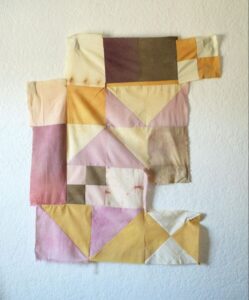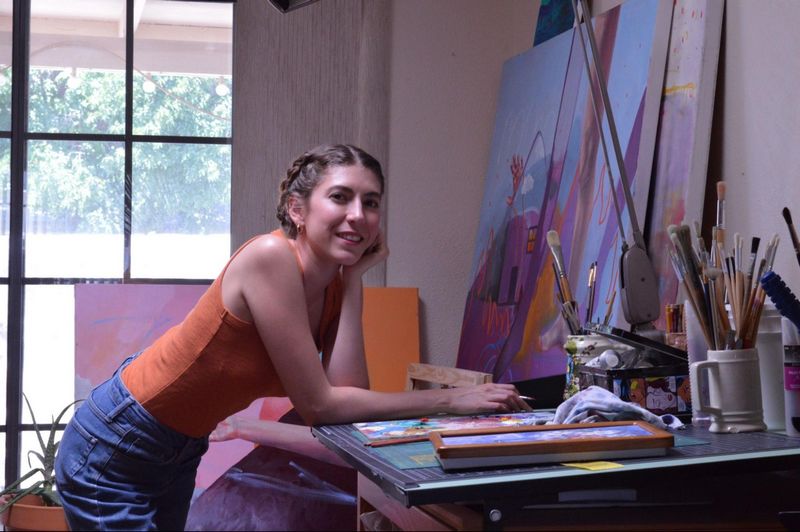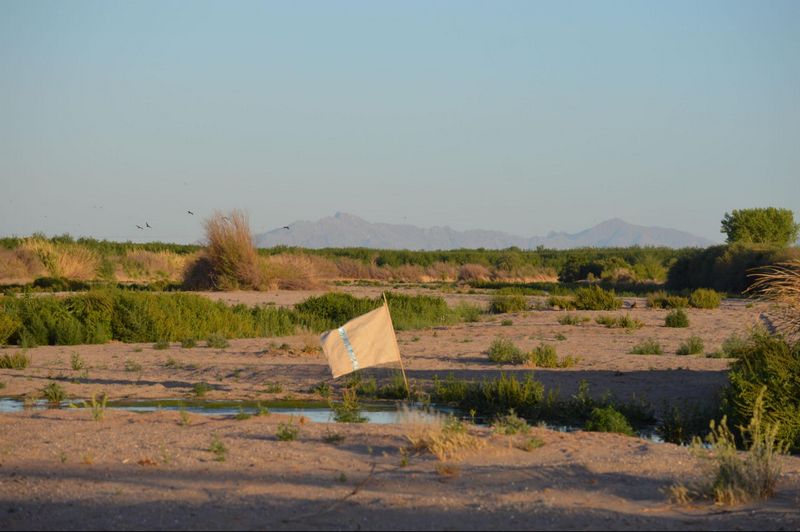Returning and Reconnecting with the Chihuahuan Desert: Eva Gabriella Flynn
2023 Chihuahuan Desert Cultural Fellowship Fellow
Eva Gabriella Flynn grew up with the expansive U.S.-Mexico border as a backdrop–a backdrop that is interwoven throughout her art to this day. As a member of the 2023 Chihuahuan Desert Cultural Fellowship cohort, she brings her experiences crossing and critiquing borders and a deepened connection with the Chihuahuan Desert ecoregion. Exploring the borderlands as a “site of paradox and contradiction,” Flynn weaves “personal memory and historical characters into the desert landscape” and challenges dominant narratives about nationalism and belonging through material culture. As a visual artist and educator, her cultural practice has evolved over the years and includes painting, drawing, textiles, and working with native plant dyes.
Setting Roots
Born in Wyoming, Flynn’s parents moved to Southern California shortly after her birth. Previously a state prosecutor, her father relocated the family when he accepted a position as an immigration attorney for what would later become the Department of Homeland Security. Her parents’ marriage and subsequent divorce would lay a foundation that has stayed with her throughout her life.
Looking back on it, it seems like such a weird paradox. It seems like, in some ways, my parents’ relationship of a Mexican immigrant and someone who ended up working for the Department of Homeland Security seemed to parallel the tensions between the U.S. and Mexico sometimes. That’s a huge inspiration for my work.
By the time Flynn was 11, her mother, who is originally from Santa Bárbara, Chihuahua, Mexico, decided to move to New Mexico to be closer to family. She spent months at a time in Chihuahua crossing borders and eventually settled in Las Cruces. Flynn felt disconnected from the region when she moved from California where she felt “one with the ocean.”
It really took a while for me to feel more connected…it was a slow creep. I always felt the Chihuahuan Desert just grew on me. Now I feel that if I went into the ocean [in California], I would feel unsteady. Where are the mountains? I just feel so grounded in the land.
Searching For and Finding Home
Flynn attended New Mexico State University (NMSU) and received a BFA in Studio Arts and a BA in Foreign Languages. She earned her MFA from the University of Wisconsin-Madison in 2021. Like many who leave the region for different reasons, she often searched for remnants of “home” when faced with culture shock of vastly different landscapes. Flynn notes a feeling of “disorientation” she felt living in the Midwest. While living in Wisconsin, she would try to find “home” through iconography and food and describes these searchings and discoveries as “caring ways for yourself in foreign territories.” She recalls seeing representations of the Virgen de Guadalupe in shop windows and feeling nostalgia and comfort. Iconography continues to play a pivotal role in her art today, and she highlights icons of the region in her pieces, including native plants, mountains, and other symbols reflective of the Chihuahuan Desert.
Living in Wisconsin at the beginning of the pandemic posed both challenges and inspiration for Flynn’s art. Unable to work in the school studios, she couldn’t paint like she used to. Oil paints are toxic, and without proper ventilation and space, she had to adjust her medium. She started to research making her own pigments, and this exploration eventually led her to native plants. When she moved back to Las Cruces in 2021, she started to research native plants from the Chihuahuan Desert and calls this returning and reconnecting with the region a “lovely byproduct” in her experiences.
Working with Native Plants
In recent years, Flynn has embarked on a new iteration of her textile work by diving deeper into native plants and natural dyes. Learning what we can respectfully use from the land and learning to take care of it go hand in hand. Flynn says it’s a matter of understanding and honoring what the land provides rather than being extractive. Being good stewards of the land, while also creating art, means embarking on a mutual relationship. Flynn continues to learn about the desert ecosystem and natural materials in the creation of her art. She uses pecan shells to make ink, and draws on other natural materials that she can find. Her mother and partner often save onion skins and other items keeping her practice in mind. She is never short of rosemary from her mother’s garden.
Flynn also engages in her own form of “urban foraging,” paying close attention to natural landscapes among the cityscape. She will wander around town and find various plants to learn and create from. Learning more about creating dyes from cochineal (insects that feed on cacti and create a stunning red color), she sees their presence on cacti around town and growing in medians. In her explorations, Flynn has witnessed an interesting contrast between native plants growing in urban areas as opposed to more open and natural spaces. She takes these experiences and translates them to different educational settings. She has presented dying workshops for the community and encourages participants to experiment and see what colors they can find and create.
As an art educator grounded in community, Flynn teaches design and drawing courses at El Paso Community College and NMSU. Growing up in public schools, she remembers art being under-funded and under-valued. While at the University of Wisconsin, she was surprised by the wealth and support that her fellow students had received. “They weren’t told they couldn’t study art,” she shares in contrast to her experience. While a student at NMSU, Flynn explains that many of her professors were not from the region and were largely white. Due to the faculty’s disconnect from the histories, experiences, and cultures of the local community, students’ learning experiences and growth as artists were stifled. This has had an impact on Flynn’s approaches to teaching today, where one of her goals is to make sure that her students are able to develop their art and their own purpose with the support of a teacher who is from and closely connected to their own communities. She works to meet her students halfway and creates space for them to value both their own contributions and their hometown.
As an educator, I want classrooms and learning materials to reflect the diverse student population. I want students to feel represented and recognized.
Current Projects
Throughout her life, Flynn has witnessed the damaging impact of increasing militarization and divisive policies have had on the border region’s people, wildlife, and ecosystem. These experiences continue to influence her art in significant ways.
I’ve always grown up in these regions that were very close to the border. As I started becoming more connected to the Chihuahuan Desert, I hadn’t thought of [it] as my home. But that entire border region is really similar [and is home]. There are the same dynamics I would see with Tijuana and San Diego [with] El Paso and Juárez.
Flynn’s work during this fellowship has been a continuation of a project she began while living in Wisconsin. “Flags for No Man’s Land” consists of handmade flags that “reference the history of the borderlands while subverting [the] national identity of [the] U.S. and Mexico.” While national symbols, like flags, have been used to unify on the grounds of nationhood, in many ways, these icons have represented divisive and exclusionary histories and policy.
 Rooted once again in the region, Flynn is continuing this project by incorporating materials sourced from the Chihuahuan Desert and within communities of Southern New Mexico, El Paso, and Ciudad Juárez. Instead of representing a specific national identity, her flags feature “the skies, mountains, and colors of the Chihuahuan Desert” and are sewn and embroidered by hand with iconography of the region. When finished, the flags will be a part of a photo series where each flag is photographed at sites across the region–including the desert and river bed from where she has sourced natural dyes and, hopefully, along the border wall. She is also working on a quilt made from scraps from the flags that will be dyed with foraged materials. The quilt represents both the growth of this ongoing project and an object of comfort, home, and belonging–something much needed in these ongoing times of division and disconnect.
Rooted once again in the region, Flynn is continuing this project by incorporating materials sourced from the Chihuahuan Desert and within communities of Southern New Mexico, El Paso, and Ciudad Juárez. Instead of representing a specific national identity, her flags feature “the skies, mountains, and colors of the Chihuahuan Desert” and are sewn and embroidered by hand with iconography of the region. When finished, the flags will be a part of a photo series where each flag is photographed at sites across the region–including the desert and river bed from where she has sourced natural dyes and, hopefully, along the border wall. She is also working on a quilt made from scraps from the flags that will be dyed with foraged materials. The quilt represents both the growth of this ongoing project and an object of comfort, home, and belonging–something much needed in these ongoing times of division and disconnect.
Flynn’s artwork will be featured at two local galleries in 2023. She will have a show at La Mecha Contemporary, a new gallery located in El Paso, TX, from July 27 to August 24th. From October 6th to December 30th, her art will be featured as part of the exhibit “Lxs Artistas Fronterizos” at the Las Cruces Museum of Art. We’ll make sure to share about these exhibits as they approach and look forward to following her cultural practice in years to come!
To learn more about Eva Gabriella Flynn and her work, visit:
https://www.instagram.com/e.gflynn/




